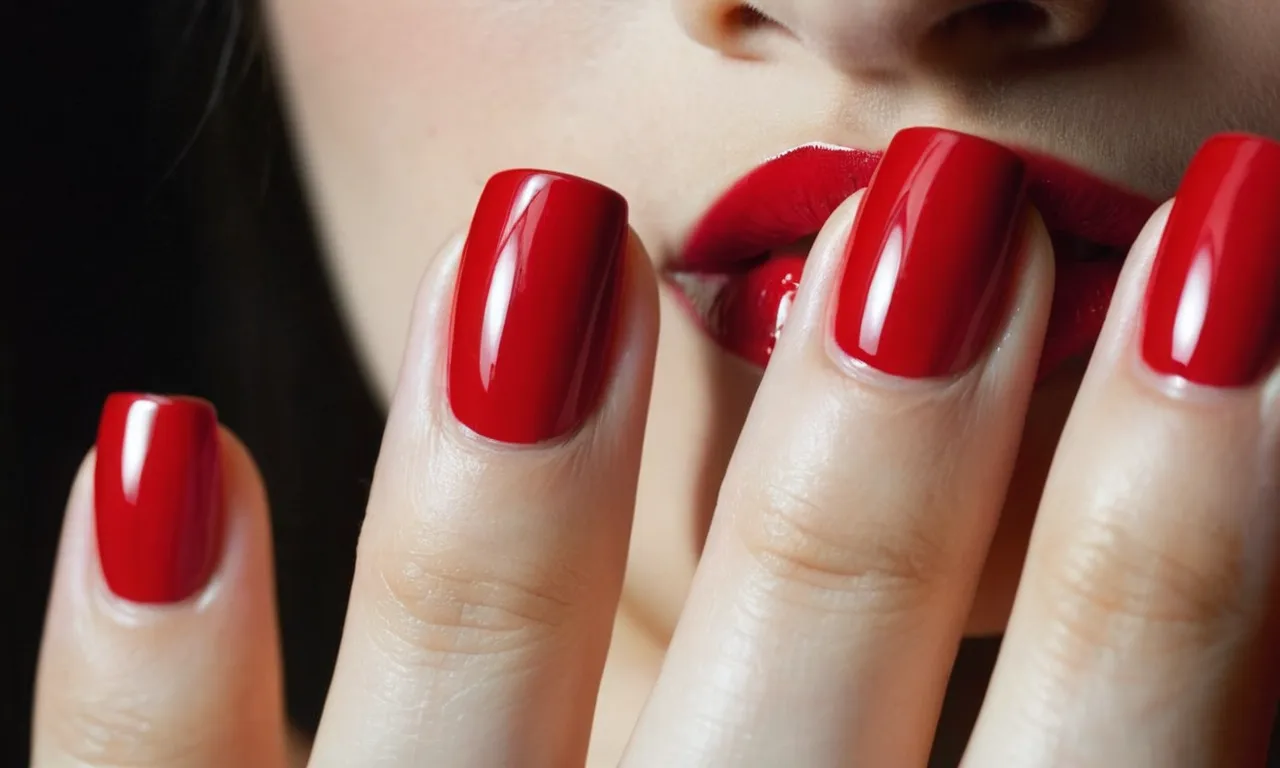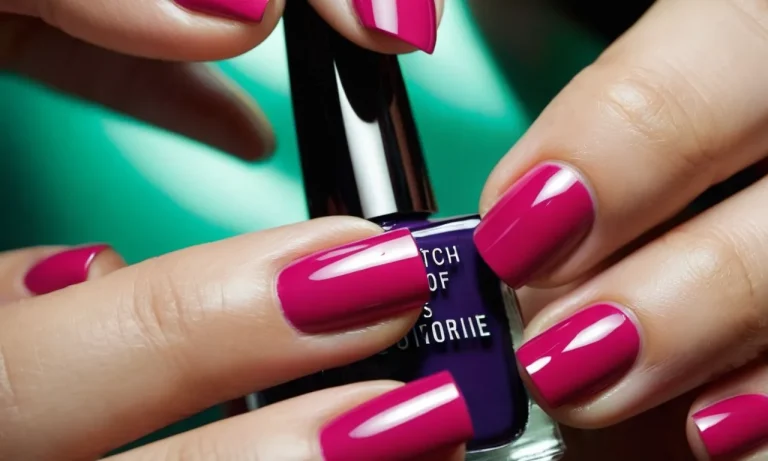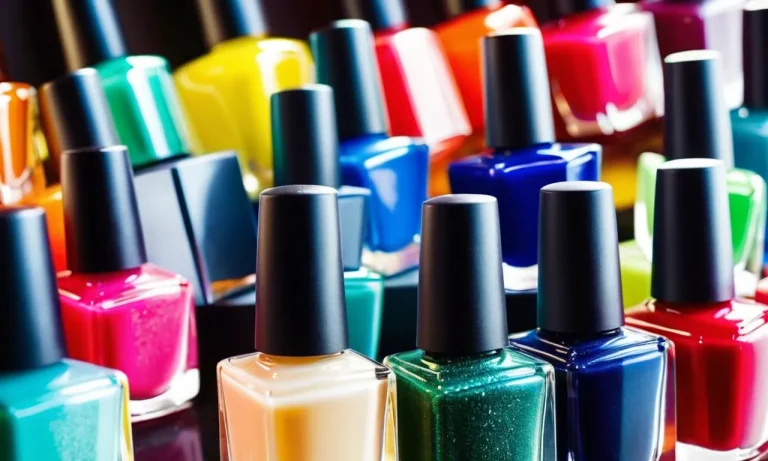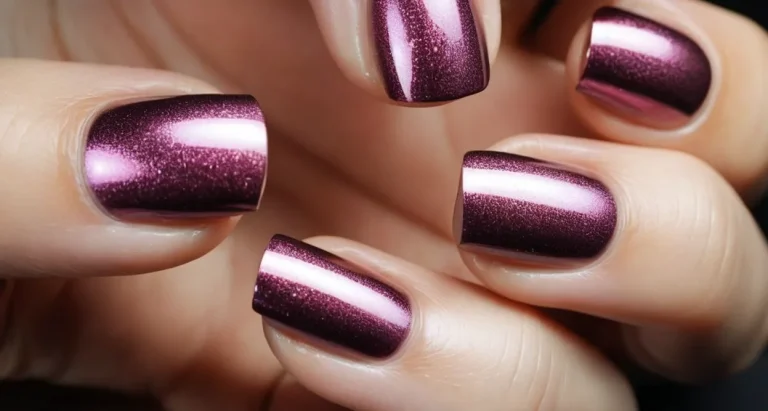Why Is My Nail Polish Sticky? Causes And Solutions
Having sticky nail polish can be annoying and ruin your manicure. If you’ve ever applied a fresh coat of polish only to have it feel gummy and tacky hours later, you’ve experienced this nuisance firsthand.
But don’t worry – with the right info, you can get to the bottom of what’s causing the stickiness and salvage your mani.
If you’re short on time, here’s a quick answer: Sticky nail polish is often caused by applying coats too thickly or too soon before the previous coat has fully dried. Other common causes are wearing base and top coat that are incompatible with the polish, using old or thickened polish, and applying nail polish in hot or humid conditions that prevent proper drying.
Applying Nail Polish Too Thickly
Thick coats lead to incomplete drying
Applying nail polish too thickly is one of the most common reasons for sticky, tacky polish that just won’t dry properly. Thick coats of polish end up forming a gummy film on the surface while the layers underneath remain wet.
This tacky layer takes much longer to dry out than thin, even coats of polish.
When too much polish is applied, it tends to pool around the nail edges. These pooled edges and streaks take the longest to dry. Frustratingly, you might think your manicure is dry to the touch, but find imprints and dents left behind hours later!
Why does thick polish take so long to dry? Nail polish is made up of a few key ingredients – most importantly, the solvent and resin. The solvent allows the polish to flow smoothly onto the nails, while the resin hardens into a glossy coating.
With thick coats, it takes much longer for the solvent to fully evaporate, especially with multiple wet layers underneath. This leaves the polish feeling sticky for hours.
How to avoid applying polish too thickly
Luckily, there are a few easy tricks to help avoid applying polish too thickly:
- Wipe excess polish off the brush before applying. This prevents flooded cuticles and streaking.
- Apply polish in multiple thin coats rather than one thick one. Let each coat dry fully before adding the next.
- Try using a lighter touch and “floating” the brush over the nail instead of pressing down.
- Avoid going over the same spot repeatedly to build up thickness.
- Wrap tips by lightly brushing over the very tip of the nail instead of flooding polish over the edges.
- Use a fast-drying top coat like Seche Vite to help cure each layer more quickly.
Taking the time to apply polish patiently in thin, even coats makes all the difference in achieving a perfect, quick-drying manicure. Just remember – less is more when it comes to nail polish application for flawless, dry nails!
Not Allowing Proper Drying Between Coats
Each coat needs time to dry before adding another
A common mistake that leads to sticky nail polish is not allowing enough time for each layer to dry before adding the next coat. Each layer of color, top coat, and base coat needs adequate drying time to set properly.
If you rush and add more polish too soon, the layers underneath won’t be fully dry and can get gummy.
Most nail polish formulas take a minimum of 2-3 minutes to dry between thin coats according to beauty experts. Some thicker polish colors or special effect shades may require 5 minutes or longer of drying time.
No matter what type of lacquer you use, resist the urge to hurry and pile on more layers. Give each application time to cure first.
Recommended drying times
Here are some general guidelines from manicurists on approximate drying times to allow between nail polish layers:
- Base coat: 2-3 minutes
- Color coats: 2-3 minutes
- Top coat: 3-5 minutes
- Quick-dry top coat: 1-2 minutes
You’ll get the hardest, smoothest finish if you let the base and color layers dry a bit longer before adding the next coating. Quick-dry top coats are formulated to cure faster than other types of polish.
Use quick-dry top coat
Using a fast-drying top coat is one of the best ways to avoid sticky nail polish issues. They contain specialized ingredients that help lacquer layers cure rapidly. This allows you to finish your manicure faster without tacky results.
Most quick-dry top coats take only 60-90 seconds to set fully. Some can transform wet color polish to a hardened, glossy finish in under a minute. When applying this type of topper, be sure previous layers like base and color coats have had 2-3 minutes to dry first.
Quick-dry top coats aren’t just for impatient types either. They create a protective barrier over nail art and delicate polishes to lock in designs. Using one can help prevent chipping and smudging for longer lasting manicures.
Using Incompatible Base and Top Coats
Chemistry between layers is important
Nail polish is made up of various chemicals that must work well together for optimal performance. The base coat, color coats, and top coat each have their own chemical formulations. When products from different brands are combined, the ingredients may react poorly with each other, preventing proper drying and causing stickiness.
For example, some base coats are designed for use with standard nail polish, while others are optimized for gel polish that requires UV/LED light curing. Mixing these base coats with incompatible color or top coats can result in tackiness.
Similarly, using a regular top coat over gel polish can also create adherence issues.
Choose products from the same brand
To avoid chemistry clashes, it’s generally best to use polishes that are designed to be used together by the same manufacturer. Nail care brands put their products through extensive testing to ensure base coats, polishes, and top coats in their ranges are compatible.
Using products from a single brand line where the ingredients are tailored to work synergistically usually prevents stickiness. For instance, OPI’s Nail Envy line has a base, color polishes, and top coat that work flawlessly together for long-lasting manicures.
Avoid mixing water-based and solvent-based
Another potential cause of tacky polish is using products with different solvents and water contents. Traditional nail lacquers contain solvents and alcohols for quick drying. In contrast, newer “three-free” and “five-free” polishes use more water for a healthier formula.
If you layer a water-based polish over a solvent-based one (or vice versa), the solvents and water can conflict. This prevents full curing and causes surface stickiness. Always check that your base coats, color polishes and top coats are either all water-based or solvent-based for best inter-coat adhesion.
Using Old or Thickened Nail Polish
Dryness and evaporation thicken old polish
It’s totally normal for nail polish to thicken over time as the solvents evaporate, leaving behind the pigments and resins. This evaporation process speeds up once you’ve opened and started using your polish.
Over the course of a year or two, it can turn from a nice creamy consistency into a goopy mess that’s hard to apply smoothly.
The main ingredients in nail polish are nitrocellulose, which provides the coating film, plasticizers to add flexibility, pigments for color, and solvents such as butyl acetate, ethyl acetate, and isopropyl alcohol to keep it flowing nicely.
Once opened, those solvents start evaporating into the air. Without enough solvent, the polish becomes dry and thick.
Replace polish every 1-2 years
The general rule of thumb is to replace nail polish every 1-2 years. Keep an eye on when you purchased or opened it. If it’s getting gloppy and thick, it’s definitely time to get a fresh bottle!
You can even mark bottles with the date opened using a permanent marker on the bottom. That makes it easy to see at a glance if it’s expired when you’re digging through your stash.
Proper storage extends the shelf life a bit longer. Keep polish in a cool, dark place and make sure the bottle is capped tightly between uses.
Restore thickened polish with thinner
If you have a beloved color that’s getting too thick but you’re not quite ready to part with it, try restoring it with nail polish thinner!
Thinner contains solvents like ethyl acetate to reconstitute the polish. Add a few drops and roll the bottle between your palms to mix. Continue adding thinner and mixing until it returns to a nice, fluid texture.
You can find nail polish thinner conveniently alongside removers and tools at beauty supply shops or drugstores. A 2 ounce bottle costs around $5. Beauty Secrets and Sally Hansen make popular, effective thinners.
Thinner brings old polish back to life, but keep in mind it won’t restore a bottle that’s rock solid. Really ancient polish may be too far gone and need to be tossed.
Avoid using harsh acetone nail polish remover as thinner, since it can curdle polish. Acetone is much too strong.
Applying in Hot or Humid Conditions
Heat and humidity prevent proper drying
Nail polish relies on rapid solvent evaporation to transition from a liquid to solid state and properly adhere to the nail plate surface. Both high temperatures and humidity levels fundamentally interfere with this crucial drying process.
Most regular nail polishes today are composed of a base formula containing various solvents, including butyl acetate, ethyl acetate and isopropyl alcohol. These volatile organic compounds (VOCs) quickly evaporate once exposed to air, allowing the solids suspended in the liquid mixture to polymerize on the nail.
However, in hot or humid weather, the evaporation rate of these solvents is substantially reduced. Moisture already present in humid air displaces the ability of additional solvent vapors to transition from liquid to gas phase.
The compromised evaporation consequently slows nail polish drying and can lead to tacky, gooey polish that never fully sets.
Avoid very hot water when washing hands
Exposing nails to hot water right before polish application should also be avoided. According to nail care experts, the ideal temperature for hand washing before a manicure is below 108°F. Water hotter than this heat threshold can deposited moisture under and around nails.
This trapped dampness is then brought into contact with the initial nail polish layers, negatively impacting evaporation, film formation and how smoothly color applies. For best results, use lukewarm water and thoroughly dry hands and nails before opening that fresh bottle of lacquer.
Turn on AC or fan to improve air circulation
To help combat high heat and humidity interfering with proper nail polish drying, turn on any available air-conditioning, fan or dehumidifier to actively circulate and refresh air around freshly painted nails.
Setting up a portable table fan directed at your hands can help whisk away ambient moisture and accelerate solvent evaporation critical for polish film formation. Frequently shaking hands while they dry also helps disturb stagnant air and refresh it with less humid surrounding air.
According to DIY experts, you can also fill a bowl with uncooked rice then place your hands atop the grains as the polish sets. The rice will help absorb excess moisture and creates a temporarily low-humidity microclimate for faster drying lacquer.
Conclusion
Sticky nail polish can put a damper on your manicure, but with some care and planning, you can avoid this pesky issue. Be mindful of polish thickness, drying times, product compatibility, the age of your polish, and environmental conditions when painting your nails.
With the right prep work, you’ll have a flawless, long-lasting manicure you can show off with pride.







